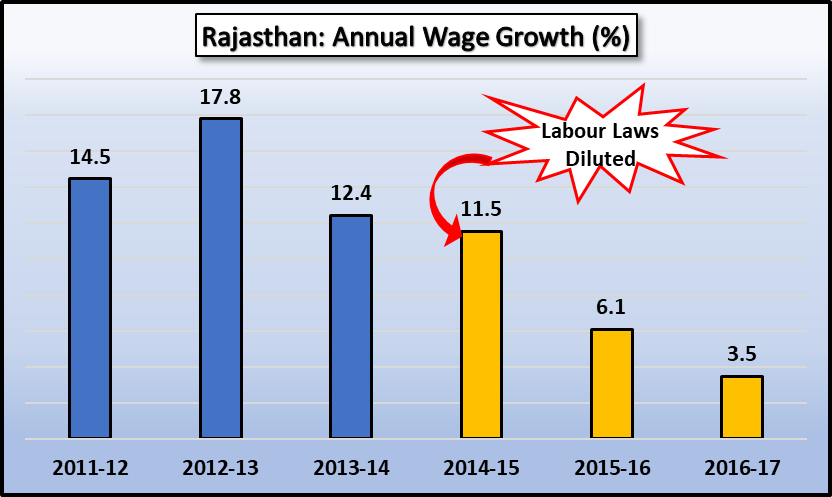How Labour Reforms Are Destroying Workers’ Lives in Rajasthan

Representational image. | Image Courtesy: YouTube
In the Economic Survey presented by the Narendra Modi government in July this year, Rajasthan was applauded for its labour law changes. It was argued that changing the “restrictive” labour laws would enhance job creation and expand industrial output because employers would feel free to hire labour. Various figures were presented to show that the number of larger factories had grown and output was higher.
What the government’s spin masters did not reveal is how workers are faring under the diluted labour laws. Data from the Annual Survey of Industries (ASI) – available only till 2016-17 – clearly shows that since the reforms were put in place in 2014-15 by the Vasundhara Raje-led Bharatiya Janata Party (BJP) government in Rajasthan, wage growth has slowed down, regular workers are being replaced by contract workers, and per worker output has increased, indicating higher exploitation. Most importantly, unemployment has increased steadily, according to the CMIE monthly series. In short, the labour reforms have destroyed workers’ lives in the state.
The changes made in labour laws included increasing the eligibility threshold for the Industrial Disputes Act and the Factories Act, thus giving a free rein to employers to hire and fire, or fix working conditions. Trade union registration eligibility was raised from 15% of workers to 30%.
Since the Modi government is now in the process of passing new central labour laws (four Codes) dismantling the existing protective labour laws, the Rajasthan example shows what is in store for workers in the rest of the country.
Contract Work Rising
As the chart below shows, the share of contract workers has risen to an astonishing high of nearly 43% of the total workforce in the factory (organised) sector. It was increasing steadily before the labour law reforms took effect, but the jump is striking. This means, lower wages, more job insecurity and more workload, with barely any social security.

Rajasthan had amended the Contract Labour Act to increase the applicability threshold from 20 to 50 persons.
Growing Unemployment
According to CMIE data, based on sample surveys, Rajasthan has a much higher unemployment rate than the country as a whole for the past two years (see chart below). In July 2019, Rajasthan’s jobless rate stood at 10.6% of the workforce while India’s was 7.5%. This is contrary to the claims made by neoliberal intellectuals that relaxing labour laws increases employment. In fact, more power to hire and fire without state regulation inevitably leads to this tragedy.

Declining Wages
ASI data strikingly shows that wage growth has plummeted after 2014-15 when the labour laws were relaxed by the BJP state government. Prior to that, it was averaging about 14-15% per year but there has been a steady dip from 11.5% in 2014-15 to 6.1% in 2015-16 and just 3.5% in 2016-17 (see chart below). In practical terms, this would mean that real (inflation adjusted) wages are stagnating or even declining.

Some may think that the units where these workers are employed are suffering from the slowing down economy and hence the employers are unable to pay better wages. While this may be a contributory factor, but the share of wages to the Net Value Added (NAV) – a measure of the output – is also declining. It has gone down from 15.6% in 2013-14 (just before the new labour laws were notified) to 14.3% in 2016-17, as per ASI data. Clearly, wage suppression is happening independent of output value (see chart below).

Increasing Exploitation
Despite declining wage growth and increasing flexibility to employers to hire and fire workers, the NAV per worker is increasing (see chart below). This means workers are working and producing more in the same time. This is the obvious consequence of lack of any regulatory control over hiring and firing, forcing the workers to increase their efficiency or workload. That this is happening despite wages stagnating, shows the intense increase in their exploitation.

All this is to do with the organised sector. One can imagine what the repercussions will be on the vast unorganised sector where most laws are not applicable or only loosely applied. The example set by the bigger units will be inexorably followed by all smaller units.
This chilling snapshot of the workers’ condition in Rajasthan, the laboratory of labour reforms, reveals the true nature of the exercise of bringing in new labour laws that the Modi government is at present so aggressively pushing. It is being deviously clothed in rhetoric about workers’ rights and protection, as also providing a boost to production. But, in reality, it is nothing but a design to boost profits by enslaving workers.
Get the latest reports & analysis with people's perspective on Protests, movements & deep analytical videos, discussions of the current affairs in your Telegram app. Subscribe to NewsClick's Telegram channel & get Real-Time updates on stories, as they get published on our website.
























